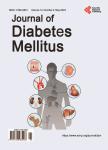Tympanometry Comparison of Diabetic Type I and Diabetic Type II Rats
Tympanometry Comparison of Diabetic Type I and Diabetic Type II Rats作者机构:School of Medicine Royal College of Surgeons in Ireland (RCSI-Bahrain) Busaiteen Bahrain Department of Physiology Arabian Gulf University (AGU) Manama Bahrain
出 版 物:《Journal of Diabetes Mellitus》 (糖尿病(英文))
年 卷 期:2023年第13卷第1期
页 面:58-67页
学科分类:1002[医学-临床医学] 100201[医学-内科学(含:心血管病、血液病、呼吸系病、消化系病、内分泌与代谢病、肾病、风湿病、传染病)] 10[医学]
主 题:Diabetes Tympanometry Auditory Function Compliance Ear Canal
摘 要:Hearing impairment affects over two-thirds of adults with diabetes. We investigated whether rat models of type 1 and type 11 diabetes display impaired auditory function. Tympanometry measurements were conducted in Sprague-Dawley rats (control, n = 20), streptozotocin-induced type I diabetic Sprague-Dawley rats (n = 20) at 42 - 56 days old;Zucker rats (Hos: ZFDM-Lean (fa/+, n = 20) and Zucker Type 2 Diabetic rats (ZFDM (Hos: ZFDM-fa/fa);n = 20)), 90 days old. All rats were male. Control animals had normal type A tympanograms. Tweny one (75%) of the tympanic membranes in the diabetic type I group produced abnormal tympanograms: 46% were type B, 28% had no peak found, and 1% were type C. The ear canal measurements were lower in the left ear in type I mice (0.19 ± 0.07) and higher in the left ear for type II mice (0.23 ± 0.15 ml) compared to the controls of 0.39 ± 0.14 ml) and (0.2 ± 0.12 ml) respectively (P 0.0001). The compliances for the right ear and left ear were lower for the type II diabetic group (0.18 ± 0.05 ml) and (0.18 ± 0.05 ml) compared to the control group (0.28 ± 0.19 ml) and (0.28 ± 0.49 ml) (P 0.0001) respectively. In conclusion, control rats exhibited type A tympanograms with a highly functional middle ear system. Diabetic type I rats (n = 20) mostly exhibited type B tympanograms with a less compliant middle ear system. Compliance was reduced in the diabetic type I and II animals compared to the control. Future studies should utilise histological methods alongside tympanometry. Sections of the middle ear could be used to analyze ossicle size and confirm size differences. This information would be useful in avenues for treatment options for hearing loss in diabetes.



